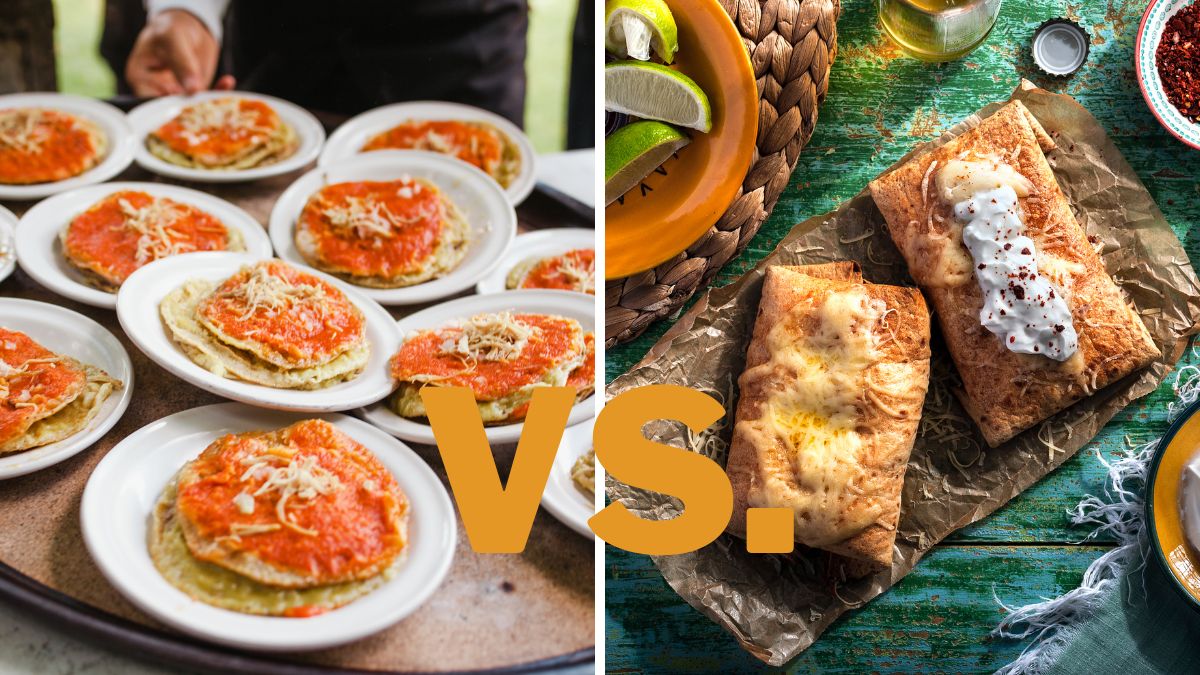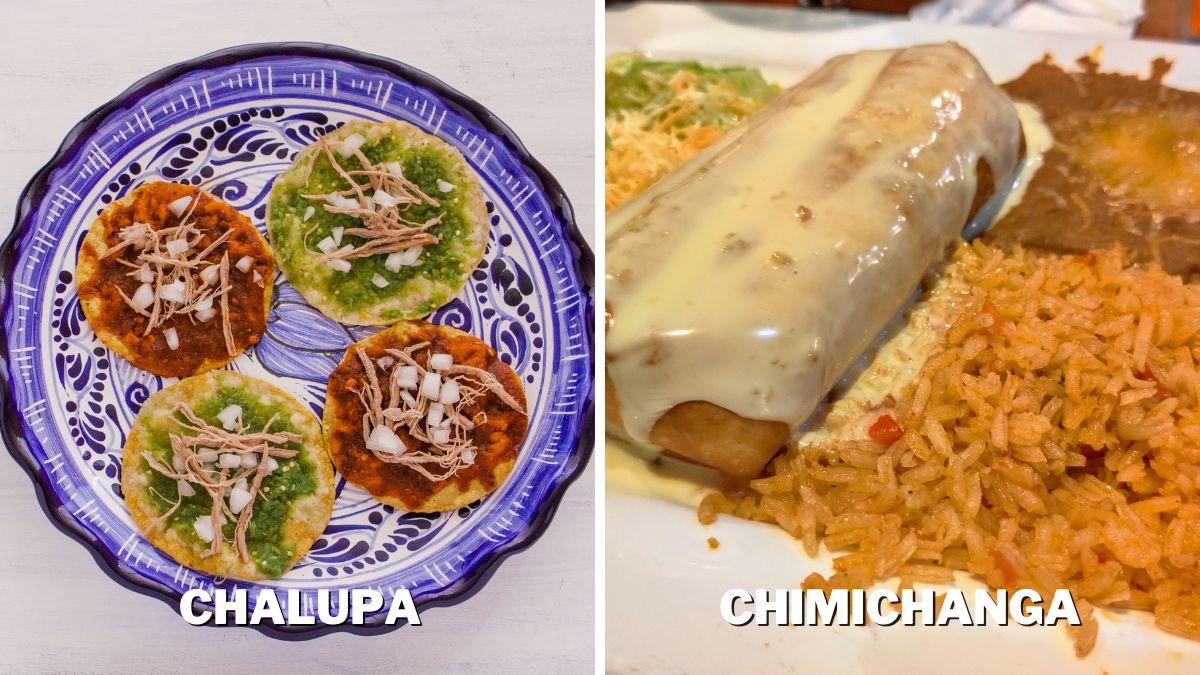Chalupa vs. Chimichanga: Differences Between Two Iconic Mexican Dishes

Food is one of my biggest passions in life. I love trying new recipes, tasting exotic flavors, and learning about different culinary traditions. As a lifelong fan of Mexican cuisine, I’ve always been curious about the subtle differences between some similar-sounding dishes. Chalupas and chimichangas are two tasty treats that people often confuse, but there are quite a few distinctions worth noting.
Chalupa has lighter ingredients and it’s served unfolded, while chimichanga is deep fried and has spicy ingredients. Both dishes share a similar Mexican-inspired heritage.
In this article, I will share what I’ve discovered about how these fried delights differ in cooking methods, fillings, toppings, and – most importantly – taste. By the end, you’ll be an expert in telling your chalupas from your chimichangas and ready to dig into whichever sounds most appetizing!
The Origins of the Chalupa and Chimichanga
As a Mexican food lover, I can tell you that chalupas and chimichangas are two of my favorite treats. While they may seem similar at first glance, some key differences exist in their origins and preparation.
The chalupa originates from Mexico and is made by frying or toasting a corn tortilla in oil until it’s lightly crispy, then topping it with fillings like meat, cheese, lettuce, and salsa. Chalupas are meant to be eaten by hand, so they’re served unfolded, but people usually fold it like a taco just right before eating it.
On the other hand, the chimichanga was created in Arizona by a Mexican cook who wanted to keep her burritos warm. She fried the burritos, and chimichangas were born!
While chalupas highlight the tortilla, chimichangas are all about the fillings inside. The frying process causes the tortilla to puff up and lock in juices from the stuffing, creating a burst of flavor in each bite.
Personally, I can’t choose a favorite – I think chalupas and chimichangas each deserve a place in my heart (and stomach!). There’s nothing quite like a taste of tradition.

Key Differences in Preparation Methods
While they may sound similar, some key differences exist in how these tasty treats are prepared.
The chalupa shell is fried or baked flatbread, usually corn tortilla, topped with fillings like meat, cheese, lettuce, and salsa. The crisp tortilla provides a nice contrast to the soft fillings.
On the other hand, the chimichanga has the fillings stuffed inside the flatbread (also tortilla in most cases) before being deep fried. The chimichanga ends up resembling a burrito, crispy on the outside and hot on the inside.
Chalupas typically have lighter fillings since the flatbread is topped after cooking. Shredded chicken, beef, or carnitas are standard, along with refried beans, lettuce, tomato, cheese, and sour cream.
Chimichangas can handle heartier fillings like rice, whole beans, and chunky salsas since the filling is encased before frying.
Both chalupas and chimichangas are meant to be customized with your favorite toppings. I like to load mine up with guacamole, salsa, cilantro, jalapeños, and maybe a queso or Mexican crema. The possibilities are endless.
Traditional Fillings for Each Dish
When it comes to traditional fillings, chalupas, and chimichangas offer some delicious options.
Ground beef, shredded beef, and shredded chicken are popular fillings for both chalupas and chimichangas. The meats are usually seasoned with chili peppers, cumin, garlic, and onion. Personally, I prefer the hearty shredded beef in my chimichanga. It holds well to the deep-frying and provides a meaty, savory bite. I like the lighter chicken filling for chalupas since the tostada shell is crunchy.
Refried beans or whole beans are also common. The refried beans have a creamy, mashed texture that works well in chimichangas, and I sincerely recommend trying them if you haven’t yet. Whole beans provide more texture for chalupas. Black beans and pinto beans are typically used. As a vegetarian option, bean fillings are satisfying and full of flavor.
Melted cheese, such as cheddar, Monterey Jack, or cotija, is a popular choice for both dishes. My favorite is the gooey Monterey Jack cheese chimichanga. The melted cheese combines with the other fillings and gets all warm and ooey-gooey inside the fried tortilla. For chalupas, a sprinkling of cotija or feta cheese provides a nice salty, tangy kick.
Other fillings include rice – especially in chimichangas, sautéed veggies like bell peppers and zucchini, and mashed potatoes. I’ve even had chimichangas filled with sweet ingredients like cinnamon sugar, fruit, or dulce de leche for dessert. The possibilities are endless!
Customizing With Toppings
When it comes to toppings, chalupas and chimichangas offer lots of delicious options for customization. Personally, I like to load up my deep-fried chimichanga with all the ingredients – sour cream, guacamole, salsa, cheese, and lettuce. The crisp, fried shell stands up well to heavy toppings without getting soggy. Chimichangas were made for piling on the extras!
I take a lighter approach with chalupas since they have an open, flatbread shell. My go-to toppings for a chalupa are:
- Salsa – Whether green chile, pico de gallo, or spicy red salsa, a spoonful of salsa adds flavor without weighing down the shell.
- Cheese – Melted cheese binds all the toppings together and gives each bite an ooey-gooey satisfaction.
- Lettuce – Fresh chopped lettuce, like romaine or cabbage, provides a nice crunchy contrast to the warm fillings and shell.
- Sour cream – A cool sour cream dollop balances salsas and chiles’ spiciness.
- Cilantro – Fresh chopped cilantro leaves give an authentic burst of flavor.
I find the lighter toppings allow the flavors of the fillings, like seasoned ground beef, shredded chicken, or refried beans, to shine through with each bite of the chalupa. The fillings aren’t obscured by too many heavy, wet toppings weighing down the shell.
For me, the key difference is how the toppings interact with and enhance the specific item. Chimichangas handle hearty toppings well, while chalupas are best topped lightly.

How Flavor Profiles Set the Dishes Apart
Chalupas and chimichangas are popular Mexican dishes, but their flavor profiles differ. As a lover of bold, spicy flavors, I tend to prefer chimichangas.
Chalupas are fried corn tortillas topped with ingredients like meat, cheese, lettuce, and salsa. The fillings are usually lightly seasoned, allowing the fresh flavors to shine through. Since the tortilla is fried, it has a light, crunchy texture that contrasts nicely with the cool, crisp lettuce. The overall taste is bright and mildly spicy.
On the other hand, Chimichangas’ fillings are heavily spiced, with ingredients like chili peppers, cumin, oregano, and garlic. Meat options include beef, chicken, or pork, and the burrito is often topped with a hearty chili or enchilada sauce, melted cheese, and sour cream.
The deep-frying process gives chimichangas a crispy, golden crust that locks in heat and moisture. When you bite into one, the spicy filling bursts with flavor. The chili and enchilada sauces add another layer of spice and tang. Compared to chalupas, chimichangas have bolder, more robust flavors from the blend of spices, sauces, and fried elements.
While both dishes are delicious in their own right, chimichangas win out for me because of their heartier, spicier taste. Chalupas are lighter and fresher but lack the richness and intensity of a well-made chimichanga.
Whether you prefer the lighter chalupa or the heartier chimichanga, both dishes will satisfy any craving for authentic Mexican fare.
